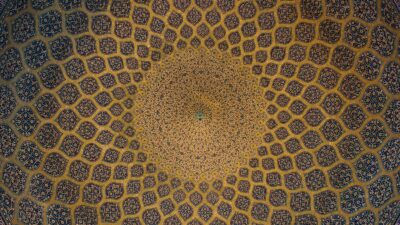In the period (260-33334/874–945), early Shī‘īsm eventually developed into Ithnā ‘Ashariyya Shī‘īsm. To gain an insight into how this process occurred, I will examine five key Ithnā ‘Ashariyya works.
The doctrine of al-Barqī and al-Saffar
The first two earliest extant compilations of Imāmi traditions by two Qummi scholars were penned by al-Barqī (d. 280/894), and al-Saffar (d. 289-290 /902-3). Qumm is a town south of Tehran and was home to numerous prominent Shī‘ī scholars from the third century onwards. These scholars were given the appellation, Qummī. Al-Barqi was a contemporary of the ninth and tenth Imāms, and al-Saffār was a companion of the eleventh Imām. As well as covering issues of fiqh, the two works devoted chapters on the status and necessity of an Imām. Al-Saffār’s work also mentions the miraculous nature of the Imām’s knowledge, and their access to hidden scriptures including the authentic version of the Quran.
The doctrine of al-Kulaynī
The third important work was written in Baghdad by Muh̩ammad b. Ya’qūb al-Kulaynī (d.329/ 941), who lived in the period between the minor and major occultation. His work, entitled al-Kafi fi ‘ilm al-dīn, contains over 16,000 traditions of the Imams on theology and fiqh, and is considered to be one of the four authoritative books of Shī‘ī h̩adīth. Building on the previous two works, Kulaynī states that the definitive source of all religious knowledge is the Ḥusaynid line of Imāms, and this can only be known through the traditions. This book is also an implicit refutation of the Mu‘tazila influenced rationalist approach among certain Shī‘as which was gaining ground in Baghdad. Regarding the status and knowledge of the Imāms, Kulaynī reiterates much of al-Saffār’s works.
However, unlike the previous two works, Kulaynī mentions traditions in which each Imām nominated his successor and, significantly, the nomination of the twelfth Imām and his occultation. So by 329/941, the concept of occultation was now backed by traditions attributed to the Imāms. However Kulaynī ‘s work contains contradictory narrations regarding the nature and length of the occultation.
The doctrine of Bābawayh
The fourth highly significant work was the collection of ninety-nine traditions of ‘Alī b. Bābawayh (d.329/941), which dealt exclusively with issue of the Imāmate. The traditions state that the Imāms are from the descendants of Ḥusayn, refute the idea that anyone other than Mūsā al-Kāẓim was the seventh Imām and state that humanity would never be left without an Imām.
However, the book does not address the issue of the occultation.This suggests that there was no unanimity on the issue amongst the Imāmis.
The doctrine of al-Nu‘mānī
Our last Shi’i scholar, Muh̩ammad b. Ibrāhīm al-Nu‘mānī (d.360 wrote Kitāb al-ghayba. Written around 954, this work shed lights on the controversial nature of the occultation issue. Nu‘mānī states that the reason for compiling his book was clarification and removal of confusion and uncertainty amongst the Imāmis on the issue of ghayba. As late as 970-1, Ibn Bābawayh was addressing the same scepticism regarding the ghayba in his Kamal. As well as reiterating traditions in the previously mentioned books, Nu‘mānī brings in additional traditions that fix the number of Imāms to twelve, and also defines the lesser and greater occultations. The alleged major occultation began in 941.
Crsystalisation of Ithnā ‘Ashariyya Shī‘īsm
The works of the five above-named scholars ensured that what was later to become Ithnā ‘Ashariyya Shī‘īsm dominated over other versions of Imāmism. The role of the Imām in Ithnā ‘Ashariyya Shī‘īsm was that of an infallible religious guide as opposed to a political leader. Furthermore, the lack of political authority was immaterial to the issue of Imāmate; Imāmate depended on nas̩s̩ and inherited knowledge and not on actual political authority. This view is diametrically opposed the Sunnī theory of leadership, in which the leader has no independent authority in religious matters.
The ambassadors
Between the periods of the minor and major occultation (260-329 / 874- 941), there were four ‘ambassadors’ who claimed to represent the hidden Imām. Only through these individuals could the faithful believers communicate with the hidden Imām. However, as previously mentioned, not every Shī‘ī believer was convinced by either the concept of the ghayba, particularly a prolonged one, nor the idea that ‘ambassadors’ had been appointed by the Imām. In addition to these four ambassadors, other individuals also claimed this privilege. Thus, a few days before his death in 329/941, the fourth ‘ambassador’ al-Sāmarrī reportedly declared that the hidden Imām had gone into the al-ghayba al-kubrā (greater occultation) and would only reappear before the end of time.
References
Abdulaziz Abdulhussein Sachedina, Islamic Messianism: The Idea of Mahdi in Twelver Shi’ism, (SUNY Press, 1981)
Andrew Newman, The Formative Period of Twelver Shi’ism: Hadith as Discourse between Qum and Baghdad (Routledge, 2013)
Daftary, F, A History of Shi’i Islam (London and New York: I.B Tauris in association with The Institute of Ismaili Studies, 2013)
Halm, H, Shi’ism (Columbia University Press, 2004)
Robert Crews, ‘Imamate’, in The Princeton encyclopedia of Islamic political thought, ed. by Richard Bulliet and David Cook (Princeton University Press,





